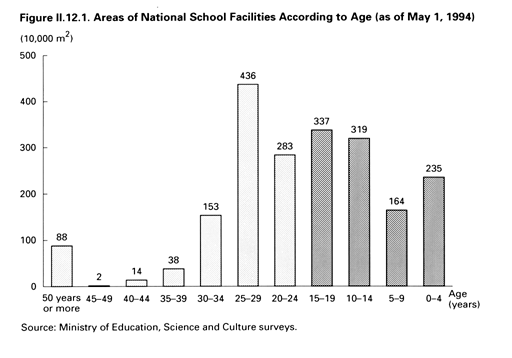| Home > Policy > White Paper, Notice, Announcement > White Paper > JAPANESE GOVERMENT POLICICIES IN EDUCATION, SCIENCE AND CULTURE 1994 > PART II Chapter 12 Section 2 2 | ||
Japan's national school facilities (universities, junior colleges, colleges of technology, interuniversity research institutes, and so on) have a combined area of approximately 20.69 million square meters (as of May 1994). This area is a reflection of the quantitative expansion of higher education in the postwar period.
The aging of facilities and the lack of space have become serious problems in recent years. Approximately 49% of national school facilities are at least 20 years old, which is the age at which renovation is normally required ( Figure II.12.1 ). These facilities are showing conspicuous signs of aging. They are also too small for present needs, and their functionality has deteriorated markedly. In addition, the lack of space in universities has become an increasingly serious prob-lem over the years due to growth in the number of graduate students and students from abroad, the increasing amount and size of experimental and research equipment, and the expanding quantity of information equipment and materials.
To overcome these problems in national school facilities it is necessary to develop and enhance education and research infrastructure to meet changing needs. The Ministry of Education, Science and Culture is implementing the following measures with the aim of establishing campuses designed for the twenty-first century. These measures are based on the perspective of developing facilities with the functions and qualitative standards needed for sophisticated and diversified educational and research activities, human and cultural environments conducive to intellectual creativity, and campuses that are open to the community.
First is the improvement of facilities that are aging or provide inadequate space. These facilities are being upgraded to provide the functions needed for modern educational and research activities through rebuilding and renovation programs and through the replacement of basic equipment. In addition, the area standards applied when developing university buildings have been revised to eliminate shortages of space for research and experiments and to meet needs created by the diversification of organizations and systems, the increasing sophistication of educational and research activities, and the shift to an information-oriented society.
Second is the development of facilities to cope with changes in higher education. Efforts in this area reflect the need to ensure an appropriate response to the demand for the development of facilities and equipment to meet needs generated by the expansion of graduate schools, the restructuring of undergraduate faculties and departments, and other changes resulting from internationalization and the shift to an information-oriented society.
The funds allocated in the fiscal 1994 budget for the improvement of national school facilities in order to realize these goals amounted to approximately 126.4 billion yen. This was 16% more than the amount provided in the fiscal 1993 budget (108.9 billion yen).
Additional project funding of 323.5 billion yen was provided in the three supplementary budgets of fiscal 1993. These funds have been used to rebuild and renovate aging facilities, provide greenery for campuses, create open spaces and other amenities, and develop campus LANs. They have also been used in areas that reflect the government's emphasis on the development of social capital responsive to the needs of consumers and communities. Projects in this category include the expansion of facilities to accommodate extension courses and the admission of adult students, the construction of resource centers to provide access to the intellectual resources of universities and university halls for use in the promotion of university-community interaction, the expansion of sports facilities to facilitate community access, and the modification of facilities to improve access for people with disabilities.

The Ministry of Education, Science and Culture is working to improve the educational and research environment through the development of buildings to accommodate expanded graduate schools and restructured undergraduate faculties and departments, the development of research and experimental facilities to meet the increasingly sophisticated requirements of research and experiments, the construction of regional joint research centers for joint research with industry, the improvement of cafeterias and other welfare facilities, and the reconstruction of schools attached to universities. The Ministry is also actively implementing the following facility-improvement measures.
| Back to Top | MEXT HOME |